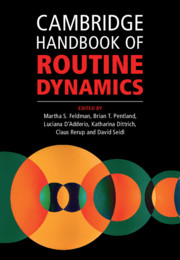Book contents
- Cambridge Handbook of Routine Dynamics
- Cambridge Handbook of Routine Dynamics
- Copyright page
- Contents
- Figures
- Tables
- Contributors
- Preface
- Chapter 1 What Is Routine Dynamics?
- Part I Theoretical Resources for Routine Dynamics Research
- Chapter 2 Practice Theory and Routine Dynamics
- Chapter 3 Process Theorizing and Routine Dynamics
- Chapter 4 Ethnomethodology and Routine Dynamics
- Chapter 5 Pragmatism and Routine Dynamics
- Chapter 6 Actor-Network Theory and Routine Dynamics
- Chapter 7 Materiality and Routine Dynamics
- Part II Methodological Issues in Routine Dynamics Research
- Part III Themes in Routine Dynamics Research
- Part IV Related Communities of Thought
- Author Index
- Subject Index
- References
Chapter 2 - Practice Theory and Routine Dynamics
from Part I - Theoretical Resources for Routine Dynamics Research
Published online by Cambridge University Press: 11 December 2021
- Cambridge Handbook of Routine Dynamics
- Cambridge Handbook of Routine Dynamics
- Copyright page
- Contents
- Figures
- Tables
- Contributors
- Preface
- Chapter 1 What Is Routine Dynamics?
- Part I Theoretical Resources for Routine Dynamics Research
- Chapter 2 Practice Theory and Routine Dynamics
- Chapter 3 Process Theorizing and Routine Dynamics
- Chapter 4 Ethnomethodology and Routine Dynamics
- Chapter 5 Pragmatism and Routine Dynamics
- Chapter 6 Actor-Network Theory and Routine Dynamics
- Chapter 7 Materiality and Routine Dynamics
- Part II Methodological Issues in Routine Dynamics Research
- Part III Themes in Routine Dynamics Research
- Part IV Related Communities of Thought
- Author Index
- Subject Index
- References
Summary
This chapter deals with the role practice theory has played and can play in developing routine dynamics and the community of scholars associated with Routine Dynamics. It provides a short introduction to practice theory. It presents an analysis of how scholars in the field of Routine Dynamics relied on practice theory to build the foundation of the field and how scholars have continued to engage practice theory as the field has grown. The chapter ends with suggestions for how practice theory could help Routine Dynamics address questions of wide social relevance.
Keywords
- Type
- Chapter
- Information
- Cambridge Handbook of Routine Dynamics , pp. 21 - 36Publisher: Cambridge University PressPrint publication year: 2021
References
- 4
- Cited by



